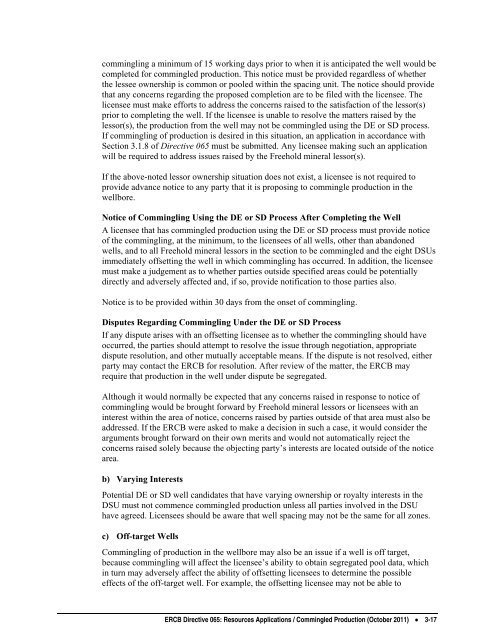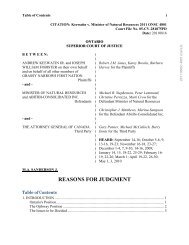Directive 065: Resources Applications for Oil and Gas Reservoirs ...
Directive 065: Resources Applications for Oil and Gas Reservoirs ...
Directive 065: Resources Applications for Oil and Gas Reservoirs ...
Create successful ePaper yourself
Turn your PDF publications into a flip-book with our unique Google optimized e-Paper software.
commingling a minimum of 15 working days prior to when it is anticipated the well would be<br />
completed <strong>for</strong> commingled production. This notice must be provided regardless of whether<br />
the lessee ownership is common or pooled within the spacing unit. The notice should provide<br />
that any concerns regarding the proposed completion are to be filed with the licensee. The<br />
licensee must make ef<strong>for</strong>ts to address the concerns raised to the satisfaction of the lessor(s)<br />
prior to completing the well. If the licensee is unable to resolve the matters raised by the<br />
lessor(s), the production from the well may not be commingled using the DE or SD process.<br />
If commingling of production is desired in this situation, an application in accordance with<br />
Section 3.1.8 of <strong>Directive</strong> <strong>065</strong> must be submitted. Any licensee making such an application<br />
will be required to address issues raised by the Freehold mineral lessor(s).<br />
If the above-noted lessor ownership situation does not exist, a licensee is not required to<br />
provide advance notice to any party that it is proposing to commingle production in the<br />
wellbore.<br />
Notice of Commingling Using the DE or SD Process After Completing the Well<br />
A licensee that has commingled production using the DE or SD process must provide notice<br />
of the commingling, at the minimum, to the licensees of all wells, other than ab<strong>and</strong>oned<br />
wells, <strong>and</strong> to all Freehold mineral lessors in the section to be commingled <strong>and</strong> the eight DSUs<br />
immediately offsetting the well in which commingling has occurred. In addition, the licensee<br />
must make a judgement as to whether parties outside specified areas could be potentially<br />
directly <strong>and</strong> adversely affected <strong>and</strong>, if so, provide notification to those parties also.<br />
Notice is to be provided within 30 days from the onset of commingling.<br />
Disputes Regarding Commingling Under the DE or SD Process<br />
If any dispute arises with an offsetting licensee as to whether the commingling should have<br />
occurred, the parties should attempt to resolve the issue through negotiation, appropriate<br />
dispute resolution, <strong>and</strong> other mutually acceptable means. If the dispute is not resolved, either<br />
party may contact the ERCB <strong>for</strong> resolution. After review of the matter, the ERCB may<br />
require that production in the well under dispute be segregated.<br />
Although it would normally be expected that any concerns raised in response to notice of<br />
commingling would be brought <strong>for</strong>ward by Freehold mineral lessors or licensees with an<br />
interest within the area of notice, concerns raised by parties outside of that area must also be<br />
addressed. If the ERCB were asked to make a decision in such a case, it would consider the<br />
arguments brought <strong>for</strong>ward on their own merits <strong>and</strong> would not automatically reject the<br />
concerns raised solely because the objecting party’s interests are located outside of the notice<br />
area.<br />
b) Varying Interests<br />
Potential DE or SD well c<strong>and</strong>idates that have varying ownership or royalty interests in the<br />
DSU must not commence commingled production unless all parties involved in the DSU<br />
have agreed. Licensees should be aware that well spacing may not be the same <strong>for</strong> all zones.<br />
c) Off-target Wells<br />
Commingling of production in the wellbore may also be an issue if a well is off target,<br />
because commingling will affect the licensee’s ability to obtain segregated pool data, which<br />
in turn may adversely affect the ability of offsetting licensees to determine the possible<br />
effects of the off-target well. For example, the offsetting licensee may not be able to<br />
ERCB <strong>Directive</strong> <strong>065</strong>: <strong>Resources</strong> <strong>Applications</strong> / Commingled Production (October 2011) • 3-17
















